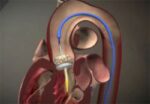Original title: Incidence and predictors of stent trombosis: a single-centre study of 5833 consecutive patients undergoing coronary artery stenting Reference: Javaid Iqbal et al. EuroInterventional 2013;9:62-69 Though potentially fatal, stent thrombosis is a low frequency event associated to stent malapposition, fractures, resistance to antiplatelet therapies, and diseases such as diabetes and kidney disease, among other factors. 5883 pacients...
Coronary Obstruction after TAVI: dreaded, but rare and solvable
Original title: Coronary Obstruction After Transcatheter Aortic Valve Implantation. A Systematic Review. Reference: Henrique Barbosa Ribeiro et al. J Am Coll Cardiol Intv 2013. Article in press. In the context of Transcatheter Aortic Valve Implantation (TAVI) there can be complications such as conduction disturbances, bleeding, residual aortic insufficiency or vascular complications, all of which have been detailed with...
Incomplete revascularization: no longer a binary variable
Original title: Residual SYNTAX score after PCI for triple vessel coronary artery disease: quantifying the adverse effect of incomplete revascularisation. Reference: Christopher J. Malkin et al. EuroIntervention 2013;8:1286-1295. In the angioplasty branch of the SYNTAX study, complete revascularization was reached in 56.7% of the population. On the other hand, in the real world, around 40% of patients that...
Bioresorbable stents produce more occlusion of the small side branches
Original title: Incidence and Short-Term Clinical Outcomes of Small Side Branch Occlusion Alter Implantation of an Everolimus-Eluting Bioresorbable Vascular Scaffold Reference: Takashi Muramatsu et al. J Am Coll Cardiol Intv 2013;6:247–57. Small Side Branch Occlusion (SBO) during coronary angioplasty has been associated with periprocedural infarction. Among the factors that cause SBO are carina displacement, plaque displacement and artery...
Ultrasound images that can predict the risk of stroke in asymptomatic patients
Original title: Asymptomatic Carotid Stenosis and Risk of Stroke (ACSRS). Reference: Stavros K. Kakkos et al. J Vasc Surg 2013;57:609-18. Despite multiple studies for a uniform approach to treat asymptomatic carotid lesions, it has not been achieved. Many factors have been proposed that contribute to the stratification including the severity of the stenosis, the plaque type, clinical, silent...
Appendage trans-catheter closure is equivalent to anticoagulation in fibrillated patients.
Original title: Percutaneous Left Atrial Appendage Closure for Stroke Prophylaxis in Patients With Atrial Fibrillation: 2.3-Year Follow-up of the PROTECT AF (Watchman Left Atrial Appendage System for Embolic Protection in Patients With Atrial Fibrillation) Trial. Reference: Vivek Y. Reddy et al. Circulation. 2013;127:720-729. Atrial fibrillation is the most common sustained arrhythmia in the world and its importance lies...
Mitraclip® year results
Original title: Residual Mitral Valve Regurgitation After Percutaneous Mitral Valve Repair with Mitraclip® System in a Risk Factor of Adverse one-Year Outcome Reference: Liliya Paranskaya et al. Catheterization and Cardiovascular Intervention 81:609-617 (2013). Currently, the gold standard for the treatment of mitral regurgitation (MR) is surgery but 20% of patients are rejected because they present a high surgical...
A worse prognosis for incomplete revascularization in both angioplasty and surgery.
Original title: The Negative Impact of Incomplete Angiographic Revascularization on Clinical Outcomes and Its Association With Total Occlusions. The SYNTAX (Synergy Between Percutaneous Coronary Intervention with Taxus and Cardiac Surgery) Trial. Reference: Vasim Farooq et al. J Am Coll Cardiol 2013;61:282–94 In patients with complex coronary artery disease who underwent coronary artery bypass surgery, (CABG), or percutaneous transluminal...
Chronic Total Occlusion: increasingly better results and fewer complications.
Original title: Angiographic Success and Procedural Complications in Patients Undergoing Percutaneous Coronary Chronic Total Occlusion Interventions. A Weighted Meta-Analysis of 18,061 Patients From 65 Studies. Reference: Vishal G. Patel et al. J Am Coll Cardiol Intv 2013. Article in press. Chronic Total Occlusions (CTOs) are found in between 15% and 30% of patients undergoing coronary angioplasty. Successful CTOs...
The radial artery is the default access for Europe.
Original title: Consensus document on the radial approach in percutaneous cardiovascular interventions: position paper by the European Association of Percutaneous Cardiovascular Interventions and Working Groups on Acute Cardiac Care and Thrombosis of the European Society of Cardiology. Reference: Martial Hamon et al. EuroIntervention 2013; 8-online publish-ahead-of-print January 2013. The European Society of Cardiology (ESC) recently published a consensus...









